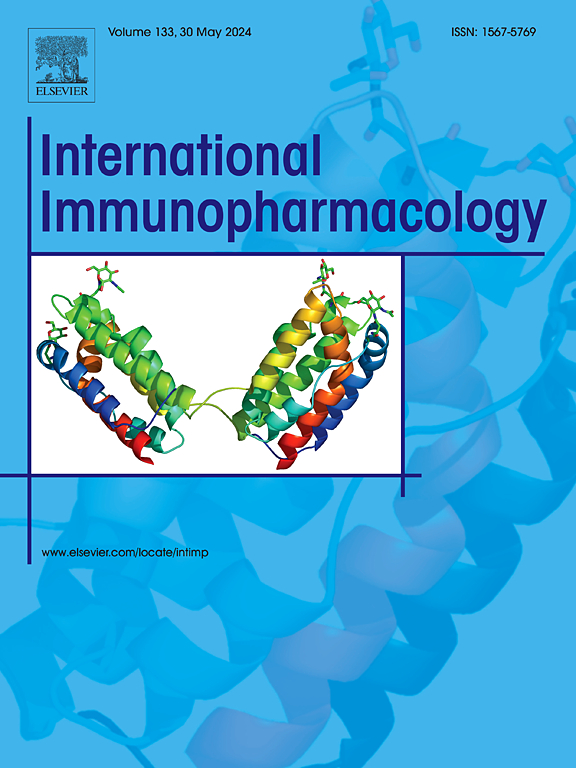Urolithin a attenuates rheumatoid arthritis by inhibiting inflammation and pyroptosis in fibroblasts via the AMPK/ NF-κB signaling pathway
IF 4.8
2区 医学
Q2 IMMUNOLOGY
引用次数: 0
Abstract
Urolithin A (UA), a metabolite of natural polyphenols produced by the gut microbiota, alleviates the symptoms of rheumatoid arthritis (RA) by inhibiting the inflammatory response. UA alleviates the clinical symptoms of RA by inhibiting the occurrence of an inflammatory response, but the specific regulatory mechanism remains unclear. In this study, we established a CIA model in 8-week-old DBA mice and chose LPS-stimulated NIH/3 T3 cells to explore the effects of UA and attempted to elucidate its potential mechanisms. Our results showed UA significantly reduced arthritis scores, and inhibited inflammation, pannus formation, and cartilage and bone destruction of inflamed joints in CIA mice. In vitro, UA inhibited LPS-induced migration and proliferation, and alleviated NLRP3-mediated pyroptosis, significantly inhibiting the protein expression levels of NLRP3, N-terminal gasdermin D, interleukin-1β, caspase-1, and ASC in NIH/3T3 cells. A mechanistic investigation revealed that LPS enhanced phosphorylation of NF-κB and downregulated that of AMPK, which were categorically counteracted by UA treatment. Therefore, UA represents a new class of promising RA treatments targeting fibroblasts, widening the therapeutic options for RA.
尿胆素 a 通过 AMPK/ NF-κB 信号通路抑制成纤维细胞的炎症和脓毒症,从而减轻类风湿性关节炎的病情
尿石素 A(UA)是肠道微生物群产生的天然多酚的代谢产物,它能通过抑制炎症反应减轻类风湿性关节炎(RA)的症状。UA 通过抑制炎症反应的发生来缓解类风湿性关节炎的临床症状,但具体的调节机制仍不清楚。在这项研究中,我们在8周大的DBA小鼠体内建立了一个CIA模型,并选择LPS刺激的NIH/3 T3细胞来探讨UA的作用,并试图阐明其潜在的机制。我们的研究结果表明,UA能明显降低CIA小鼠的关节炎评分,抑制炎症小鼠关节的炎症、骨痂形成、软骨和骨破坏。在体外,UA可抑制LPS诱导的迁移和增殖,缓解NLRP3介导的热蛋白沉积,明显抑制NLRP3、N-端gasdermin D、白细胞介素-1β、caspase-1和ASC在NIH/3T3细胞中的蛋白表达水平。一项机理研究显示,LPS增强了NF-κB的磷酸化,并下调了AMPK的磷酸化,而UA处理则完全抵消了这一作用。因此,UA代表了一类新的针对成纤维细胞的有前景的RA治疗方法,拓宽了RA的治疗选择。
本文章由计算机程序翻译,如有差异,请以英文原文为准。
求助全文
约1分钟内获得全文
求助全文
来源期刊
CiteScore
8.40
自引率
3.60%
发文量
935
审稿时长
53 days
期刊介绍:
International Immunopharmacology is the primary vehicle for the publication of original research papers pertinent to the overlapping areas of immunology, pharmacology, cytokine biology, immunotherapy, immunopathology and immunotoxicology. Review articles that encompass these subjects are also welcome.
The subject material appropriate for submission includes:
• Clinical studies employing immunotherapy of any type including the use of: bacterial and chemical agents; thymic hormones, interferon, lymphokines, etc., in transplantation and diseases such as cancer, immunodeficiency, chronic infection and allergic, inflammatory or autoimmune disorders.
• Studies on the mechanisms of action of these agents for specific parameters of immune competence as well as the overall clinical state.
• Pre-clinical animal studies and in vitro studies on mechanisms of action with immunopotentiators, immunomodulators, immunoadjuvants and other pharmacological agents active on cells participating in immune or allergic responses.
• Pharmacological compounds, microbial products and toxicological agents that affect the lymphoid system, and their mechanisms of action.
• Agents that activate genes or modify transcription and translation within the immune response.
• Substances activated, generated, or released through immunologic or related pathways that are pharmacologically active.
• Production, function and regulation of cytokines and their receptors.
• Classical pharmacological studies on the effects of chemokines and bioactive factors released during immunological reactions.

 求助内容:
求助内容: 应助结果提醒方式:
应助结果提醒方式:


